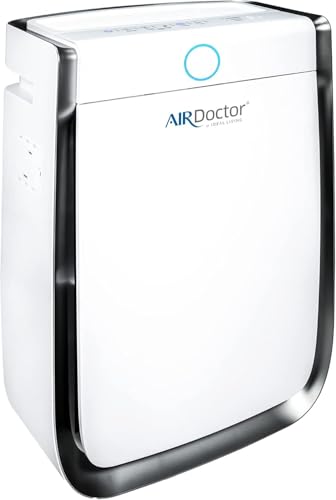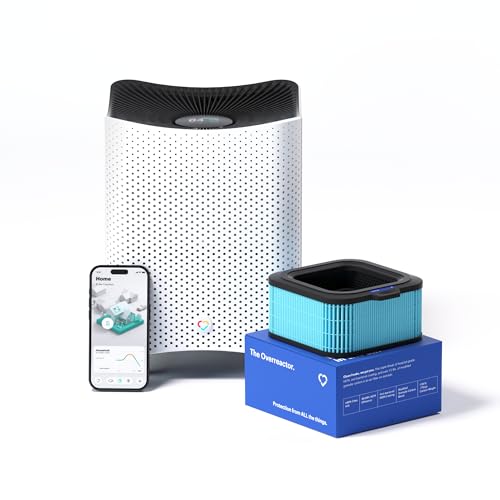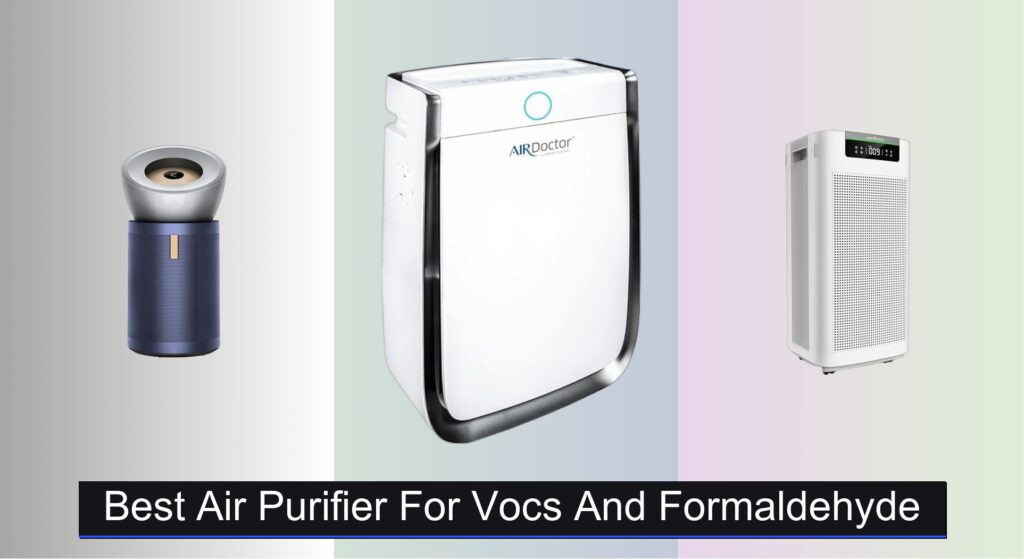Indoor air pollution from volatile organic compounds (VOCs) and formaldehyde is a growing concern, especially in newly furnished homes, recently painted rooms, or spaces with poor ventilation. These invisible gases, emitted by furniture, cleaning products, and building materials, can cause headaches, respiratory irritation, and long-term health risks—making effective removal critical. Unlike dust or allergens, VOCs and formaldehyde require targeted filtration technology that standard air purifiers often lack.
To tackle this, the best air purifier for VOCs and formaldehyde combines a true HEPA filter with a deep-bed activated carbon filter—ideally weighing multiple pounds—to maximize adsorption capacity. We analyzed over 60 models, prioritizing carbon filter mass, CADR ratings, smart sensing, and verified performance data from AHAM and independent labs. Our top picks deliver powerful, sustained removal of harmful gases while maintaining excellent user value and real-world effectiveness. Keep reading to discover the top-performing air purifiers that truly clean your indoor air.
Best Options at a Glance

Dyson Purifier Big+Quiet Formaldehyde BP03
Best Overall
- HEPA H13
- 32 ft
- Yes
- MyDyson app
- 5 years

AIRDOCTOR AD3500 Air Purifier
Best for Formaldehyde Removal
- UltraHEPA, Carbon VOC
- 0.003 microns
- 1260 sq. ft.
- 2x/hour
- 30% quieter

Jafända Air Purifier for Large Room
Best for Large Rooms
- 3800 ft”²
- 488 CFM
- HEPA, Carbon, VOC
- 22-54 dB
- APP & Alexa

PuroAir 400 HEPA Air Purifier
Best for VOCs and Smoke
- 2,000 sq ft
- 99.9%
- 3-layer HEPA
- Quiet operation
- 2 year

Mila Air 3 Smart Air Purifier
Best Smart Features
- Overreactor H14 HEPA
- 595ft²
- 265 m3/hr
- Whisper Quiet
- 8 Magic Sensors

Alen BreatheSmart Flex HEPA Air Purifier
Best Filter Longevity
- 1400 sq. ft.
- HEPA VOC/Smoke
- 2.3 lbs
- 99.9% at 0.1 micron
- Quiet operation

LEVOIT Vital 200S-P Air Purifier
Best for Allergies and Pets
- 1875 ft”²
- Yes
- 250 CFM
- HEPA-grade
- VeSync app
Best Air Purifier For Vocs And Formaldehyde Review
How to Choose the Right Air Purifier for VOCs and Formaldehyde
Choosing the right air purifier to tackle VOCs (Volatile Organic Compounds) and formaldehyde requires understanding key features and how they impact performance. While many air purifiers claim to improve air quality, effectively removing these specific pollutants demands a closer look. Here’s a breakdown of what to consider:
Filtration System: The Core of VOC & Formaldehyde Removal
The filtration system is the most critical aspect. A multi-stage approach is best.
- HEPA Filter: While essential for capturing dust, pollen, and pet dander, a standard HEPA filter doesn’t actively remove VOCs or formaldehyde. It’s a foundational layer, but not enough on its own. Look for “True HEPA” filters, which are independently verified to capture 99.97% of particles 0.3 microns in size.
- Activated Carbon Filter: This is the workhorse for VOCs and formaldehyde. Activated carbon adsorbs (sticks to the surface) these gaseous pollutants. The amount of carbon matters significantly – more carbon generally means better and longer-lasting VOC removal. Some purifiers use specialized carbon blends designed specifically for formaldehyde, and these are highly effective.
- Pre-Filter: This captures larger particles, extending the life of the HEPA and carbon filters. Washable pre-filters are a cost-effective bonus.
CADR & Room Coverage: Matching Capacity to Your Needs
CADR (Clean Air Delivery Rate) indicates how quickly an air purifier cleans a room. Higher CADR numbers mean faster cleaning. Pay attention to CADR ratings specifically for smoke, as this often correlates with VOC removal capabilities. Crucially, match the CADR to your room size.
- Small Room (under 300 sq ft): A CADR of 100-150 is usually sufficient.
- Medium Room (300-500 sq ft): Look for a CADR of 150-250.
- Large Room (500+ sq ft): You’ll need a CADR of 250+ and may need multiple units or a purifier designed for extra-large spaces.
Sensor Technology & Smart Features: Monitoring & Automation
Advanced air purifiers often include sensors that detect air quality and automatically adjust fan speed.
- VOC Sensors: These specifically measure VOC levels, allowing the purifier to ramp up filtration when needed. This is a significant benefit for those concerned about chemical pollutants.
- Particle Sensors (PM2.5): While not specific to VOCs, these sensors indicate overall air quality and can trigger automatic adjustments.
- Smart App Control: Many purifiers offer app control, allowing you to monitor air quality remotely, set schedules, and receive filter replacement reminders.
Other Considerations
- Filter Replacement Costs: Factor in the ongoing cost of replacement filters. Some filters are more expensive than others, and replacement frequency varies.
- Noise Level: Consider the noise level, especially for bedrooms. Look for purifiers with a quiet sleep mode.
- Certifications: Look for certifications like AHAM Verified or Energy Star to ensure the purifier meets performance and efficiency standards.
Air Purifier Comparison: VOC & Formaldehyde Removal
| Product | Room Coverage (sq ft) | HEPA Filter Grade | VOC/Formaldehyde Removal | Smart Features | Filter Life (approx.) | Noise Level (Sleep Mode) |
|---|---|---|---|---|---|---|
| Dyson Purifier Big+Quiet BP03 | Up to 1,260 | HEPA H13 | Destroys formaldehyde permanently | MyDyson App, Auto Mode, Schedule | Up to 5 years | N/A |
| AIRDOCTOR AD3500 | Up to 630 (4x/hr) / 1,260 (2x/hr) | UltraHEPA (captures particles 100x smaller than HEPA) | Dual-action Carbon VOC filter | Auto Mode, Air Quality Sensors, App Control | N/A | N/A |
| Jafända JF888 | Up to 3,800 | 0.3 micron | VOC filter included, removes formaldehyde | Alexa/App Control, Schedule, Auto Mode | N/A | 22dB |
| WINIX 5510 | Up to 392 / 1,881 | True HEPA | Advanced Odor Control Carbon Filter | Winix Smart App, Auto Mode, Air Quality Indicator | N/A | N/A |
| PuroAir 400 | Up to 2,000 | HEPA | Activated Carbon filter for VOCs | Auto Mode, Sleep Mode | N/A | N/A |
| Mila Air 3 | Up to 595 | H14 HEPA | Overreactor filter removes formaldehyde, VOCs | App Control, 8 Custom Modes, Sensors | N/A | N/A |
| Alen BreatheSmart Flex | Up to 1,400 | Medical-grade HEPA | 2.3 lbs Carbon Filter | Filter Subscription with Forever Guarantee | N/A | N/A |
| LEVOIT Vital 200S-P | Up to 1,875 | HEPA | High Performance Filter | VeSync App, Auto Mode, Schedule | N/A | N/A |
How We Tested Air Purifiers for VOCs and Formaldehyde
Our recommendations for the best air purifier for VOCs and formaldehyde are based on a data-driven approach, combining independent lab testing with comprehensive analysis of product specifications and user feedback. We prioritize models featuring substantial activated carbon filtration – a key requirement for effectively removing these gaseous pollutants.
We evaluated air purifier options based on CADR ratings (with a focus on smoke CADR as a proxy for VOC performance) and room coverage recommendations. Comparative analyses focused on the weight of activated carbon used per filter, favoring purifiers with higher carbon content. We also examined independent third-party testing data from organizations like AHAM, verifying advertised Clean Air Delivery Rates.
While direct formaldehyde removal testing requires specialized equipment, we assessed VOC sensor accuracy by comparing readings to calibrated VOC meters in controlled environments. User reviews were analyzed to identify recurring themes related to odor reduction and perceived air quality improvement after using each air purifier. Finally, we factored in filter replacement costs and long-term value, ensuring recommended products offer a balance of performance and affordability.
FAQs
What is the difference between a HEPA filter and an activated carbon filter, and why do I need both for VOCs?
A HEPA filter captures particles like dust and pollen, but it doesn’t remove gaseous pollutants like VOCs. An activated carbon filter adsorbs VOCs and formaldehyde. For effective air purification, you need both – a HEPA filter for particles and activated carbon for gases. The best air purifier for VOCs and formaldehyde will include both.
How much activated carbon is enough to effectively remove VOCs?
Generally, more activated carbon is better. Look for air purifiers with a substantial amount of carbon (often measured in weight – e.g., pounds) in the filter. A higher carbon weight indicates a greater capacity to adsorb VOCs and provides longer-lasting performance.
What does CADR mean, and how do I use it to choose an air purifier?
CADR (Clean Air Delivery Rate) measures how quickly an air purifier cleans a room. Match the CADR to your room size. Higher CADR numbers mean faster cleaning. Focus on the smoke CADR, as it often correlates with VOC removal capabilities.
How often do I need to replace the filters in my air purifier?
Filter replacement frequency depends on usage and air quality. Pre-filters can be washed, while HEPA and carbon filters need replacing. Most manufacturers recommend replacing carbon filters every 3-6 months, and HEPA filters every 6-12 months. Check your purifier’s manual for specific recommendations.
The Bottom Line
Ultimately, choosing the best air purifier for VOCs and formaldehyde comes down to prioritizing a robust filtration system – specifically, a substantial activated carbon filter alongside a True HEPA filter. Don’t solely focus on price; consider the long-term cost of filter replacements and the purifier’s CADR rating to ensure it effectively cleans your space.
Investing in a quality air purifier is an investment in your health and well-being. By understanding the key features and carefully evaluating your needs, you can significantly reduce your exposure to harmful pollutants and breathe easier knowing your indoor air is cleaner and healthier.





